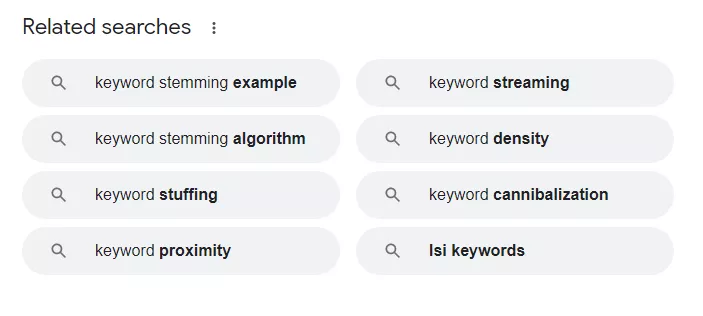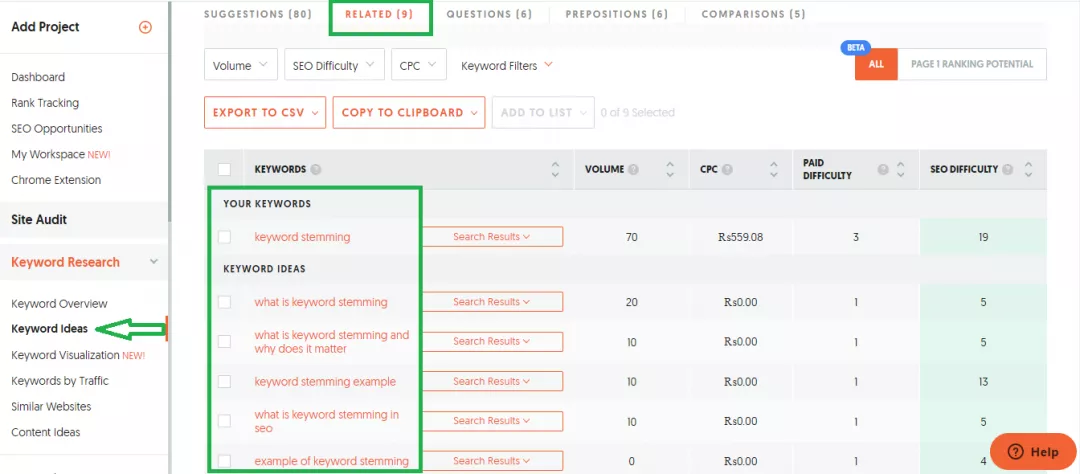What is Keyword Stemming?
Keyword stemming is a technique used by search engines to recognize and understand different variations of a specific search term.
This process involves identifying the base or root form of a word and its variations by adding prefixes, suffixes, or plural forms to improve the accuracy of search results.
The purpose of keyword stemming is to avoid the overuse of a particular term or phrase by identifying variations of the same word.
For instance, if you use the word "freelance" in an article, you might change it to "freelancer" or "freelancing" to avoid duplication and improve the search engine's ability to understand the context.
Is it good or bad?
It is considered good practice to use keyword stemming if it does not change the meaning of the sentence.
However, if the content is full of similar keywords that have slight variations, it may be necessary to use keyword stemming to avoid overusing the same term.
Sometimes, people use keyword stemming in a way that changes the sense of the word and alters the meaning of the sentence.
For example, adding the prefix "in" to "valuable" is acceptable, while adding the suffix "less" changes it to "valueless," which is the opposite of the original word.
This can result in a sentence with a different meaning or the need to add another sentence to adjust for the variation, which is not ideal.
Was it popular in the past?
Keyword stemming was not widely used in the past because Google did not place much emphasis on this technique of adding variations in the content. As a result, people have been using it excessively.
However, with Google's algorithm becoming more sophisticated and focused on quality content, keyword stemming has become a technique that can lead to a lower ranking.
Therefore, it is essential to use keyword stemming carefully and only when necessary to avoid penalties and maintain high-quality content.
Difference between stemming and lemmatisation
Stemming and lemmatisation are two techniques used in natural language processing to extract the base form of a word from its different variations.
However, they are often used interchangeably due to a slight difference between them that can be confusing.
Stemming focuses on returning to the main word from which different forms are derived, such as by adding prefixes or suffixes. In contrast, lemmatisation is more about understanding the context of the word and its true meaning.
For instance, consider the sentence "Studying the entire course wasn't an easy task".
If the word "studying" undergoes stemming, the algorithm will only recognize "study" with the "ing" ending, without considering its context.
In contrast, if lemmatisation is used, the algorithm will understand that "studying" is a gerund - which is a noun made by adding "ing" to a verb, within the context of the sentence.
Similarly, in the sentence "He was studying a book", lemmatisation will recognize "studying" as a verb in the continuous tense, whereas stemming will only return "study" with the "ing" ending.
Both techniques aim to help algorithms identify the root or origin of words to detect natural or unnatural textual content.
However, lemmatisation provides more accurate results than stemming by taking into account the word's context and true meaning.
Is it a ranking factor?
Stemming should not be considered a ranking factor as it is unlikely to significantly impact your search engine rankings.
Instead, it is more important to focus on search intent when creating content that satisfies readers' needs and attracts organic traffic.
It is not advisable to waste time excessively using stemming techniques to create variations of similar words.
The focus should be on creating high-quality content that meets the user's search intent.
However, if you overuse stemming to stuff your content with similar words with slight variations, you may experience a de-ranking.
This is because search engines prioritize content that provides value to users over content that is stuffed with keywords.
Therefore, it is essential to use stemming judiciously and only when it improves the content's readability and context.
How to create appropriate variations?
The strategy of creating variations is acceptable when your content is natural, but the repetition of words makes it boring. To avoid this, you can try the following ways.
Google’s suggestions
The best and most authentic way to search for keywords is to follow Google's suggestions.
For example, related words and phrases can be found at the bottom of the search engine results pages or in the "People also ask" box.
By incorporating these related words into your content, you can make it more comprehensive and natural-sounding.

SEMrush’s Keyword Magic Tool
SEMrush's Keyword Magic Tool is a helpful tool for finding variations of seed keywords.
It can provide you with natural forms of a keyword and insights into the traffic and search volume of those keywords.
Using this tool, you can enter a seed keyword and receive a list of related keywords and their search volume, competition, and other metrics.
This information can help you choose the best keywords for your content and understand the potential traffic you may receive.
Ubersuggest
Ubersuggest is a helpful tool for generating suggestions regarding variants of stem keywords or phrases.
By entering your seed keyword or phrase, you can receive numerous suggestions related to potential keywords and their ranking potential.
Using Ubersuggest, you can improve your search engine rankings by incorporating relevant keywords into your content and ensuring that you are targeting the most valuable keywords for your niche.

Conclusion
Stemming may or may not cause issues for your search engine rankings, depending on how you use it.
It is important to ensure that your content sounds natural to attract organic traffic.
To avoid overusing stemmed keywords, it is important to review your content and identify areas where there is too much repetition of the same words.
You can use keyword research tools or Google's related words and phrases to find suitable alternatives.
By incorporating natural variations of stemmed keywords into your content, you can improve its readability and ensure that it satisfies the user's search intent.
This approach can help you avoid penalties for keyword stuffing and maintain high-quality content that ranks well in SERPs.


